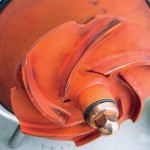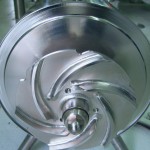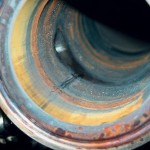Rouging occurs in hot pure water and pure steam systems. The very low-ion water in these systems has a corrosive effect on the Cr-Ni and Cr-Ni-Mo alloys under operating conditions. A thin deposit forms on the metal surface for this reason. The aim is to avoid rouging from the minute the system starts up. If this is not possible, the deposits must be removed regularly.
If the pure water and pure steam systems are affected by rouging, they exhibit surface colouring from golden yellow or light blue to violet or reddish-brown nuances. Greyish-black deposits, so called blacking, are also observed in pure steam systems at high temperatures. Initially, these deposits are still slightly transparent. In the course of operation, they can form chalky or crys-talline surface structures. When they reach an advanced stage, more and more particles are liable to be detached. Whether or not rouging occurs in the system depends first and foremost on the selected material. Both plastic, e. g. PVDF, and metallic materials can basically be used for pure water or pure steam systems. No rouging occurs if plastics are chosen. On the other hand, plastic systems have the disadvantage of significantly greater thermal expansion (deformation) in the event of high-temperature interaction processes and they also age faster. These problems can be avoided by employing metallic materials for all water or steam-contacting parts. In practice, stainless steels are a popular choice, especially Cr-Ni-Mo alloys (e. g. DIN material nos. 1.4404/1.4435 (316L) and 1.4571 (316Ti)). However, like high-alloy steels (e.g. DIN material no. 1.4539), these materials are susceptible to rouging.
When the stainless steel is in a steady state of equilibrium, a very thin chromium oxide layer forms on the material surface in the presence of oxygen. This passive layer normally protects the material from corrosion in contact with neutral water so- lutions (medium). In pure water media at higher temperatures, however, the passive layer can be corroded, leading to the formation of various iron oxides and hydroxides. The rough black deposits in steam systems are mainly magnetite layers (Fe3O4). The details of the rouging mecha-nism are still being investigated. One theory is that, owing to the structure defects in the passive layer, the iron ions migrate to the surface and are oxidised. The insoluble iron oxides can be entrained by the water to various points on the surface and re-deposited. This would explain why, for example, PTFE gaskets can be covered with rouge or why pump covers and impellers are particularly susceptible. Since the particles are very small (<1 µm), it is difficult to make them visible, in other words to sepa-rate (capture) them in a standard filter. To restrict the occurrence of material-related rouging to a minimum, all surfaces should preferably be clean and free from defects. Considerable manufacturing and installation expertise is essential, because defects are inherently present in the material and each individual defect can in turn affect the passive layer. Thorough chemical cleaning or passivation is recommended to ensure optimal basic conditions after processing.
Factors influencing rouging
As mentioned earlier, it is the operating conditions that are ultimately responsible for the aggressivity of water and pure steam. The operating temperature, the sanitisation processes and the composition of the steam and water appear to be especially important. Experience has shown that rouging increases as a function of the water temperature and that its intensity can also be very localised. Pumps are much more prone than pipe sections, for instance, and the deposits on welds are different from those on the base material. Rouging is particularly likely in defective installations (poor welding, components made from an inferior alloy). In addition, rouge deposits with different adhesion properties are often encountered on one and the same part. Thicker deposits can usually be wiped off, although the effort for cleaning increases in line with the layer thickness. Rouging is commonly observed in conjunction with hot storage of WFI (Water For Injection) distribution systems, where the temperature exceeds 80 °C. To minimise rouging, therefore, the temperature should be no higher than is necessary to assure correct operation. Frequent steam and water sanitising processes also favour rouging. It is consequently advisable to define meaningful sanitising intervals based on monitoring results. The steam composition is another important parameter. CO2, which encourages carbonic acid formation, should be avoided. Pure nitrogen/oxygen atmospheres are likely to be less sympathetic to rouging. A analysis of the water quality is required. The aim should be to eliminate, for example, iron, manganese, silicic acid, CO2 and chloride ions as far as possible.
A general recipe for avoiding rouging has yet to be found. However, regular system inspections permit a reliable prediction regarding the condition and evolution of the components. A system that is periodically treated or cleaned is more resistant to the formation of new rouge deposits. Removing rouge represents a difficult challenge owing to its insolubility. Beratherm can provide qualified support in this connection. The chemical cleaning solutions used must be capable of removing deposits without damaging the electropolished surfaces or corroding the material. If the deposits are particularly difficult to dissolve, the solution potential must be increased. Solutions based on nitric acid, phosphoric acid, citric acid or speciality chemicals from reputed manufacturers are suitable. Ideally, experiments should be conducted upfront in the laboratory on representative sample material. As a rule of thumb, the effort for derouging increases the longer the operating time. A typical derouging process could comprise the following steps:
- Alkaline pre-treatment/degreasing
- Rinsing (intermediate)
- Derouging with a suitable reagent
- Rinsing (intermediate)
- Acid cleaning/repassivation
- Rinsing (until the solution becomes neutral)
- Rinsing with conductivity control
A detailed system analysis and prior clarification, consideration of all safety aspects, the use of GMP-compliant and certified chemicals, residue-free removal of all chemicals, full documentation of all processes carried out and expert disposal of the treatment media are vital for efficiency. Regular derouging in the framework of plant inspections improves operating reliability and avoids an intensive build-up of deposits on the material surfaces.
cpp 431
Derouging
Literatur
Share:









